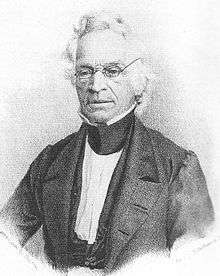George Brown (financier)

George Brown (1787–1859) was an Irish-American investment banker and railroad entrepreneur. He emigrated from Ulster to Baltimore, Maryland, at the age of 15 in 1802.[1]
He eventually joined his father, Alexander Brown (1764–1834), in the family business, Alex. Brown & Sons, which became one of the leading investment banks of the U.S. in the nineteenth century. In 1818, George partnered with his brother John in starting the firm of Brown Bros. & Co. in Philadelphia, Pennsylvania.[1]
George Brown had a prominent role in the founding of the Baltimore and Ohio Railroad (B&O), the first common carrier railroad in the U.S.[2] On February 12, 1827, he hosted a meeting at his Baltimore home for 24 leading merchants, where Philip E. Thomas joined Brown in advocating the formation of a railroad to make Baltimore competitive with other eastern seaboard ports. Concerned at the potential effect of canals, particularly the successful Erie Canal (completed in 1825) and others being planned, such as the C&O Canal to Washington, D.C., he served on the committee which studied the development of railroads in Great Britain. At a subsequent meeting in Brown's house (near where Baltimore's City Hall now stands), the committee concluded that the then-unproven technology of a long-haul railroad was feasible and that considerable trade "would flow into the State of Maryland, upon the proposed Rail Road," the committee's report concluded.[1]The state agreed, approving a charter for the B&O Railroad on March 13, 1827. Thereafter, the Mechanics Bank of Baltimore, where George Brown and Philip E. Thomas were officers, had a leading role in the financing and sale of B&O stock for construction of the first railroad in the U.S.[1][3]
George Brown was subsequently elected as the B&O's first treasurer.[2] He later succeeded his father in 1834 as head of Alex. Brown & Sons.
The Brown Memorial Presbyterian Church of Baltimore, Maryland was built in 1870 in his memory, funded by Brown's wife, Isabella McLanahan Brown. His brothers were William, John, and James.
References
- 1 2 3 4 Dilts, James D. (1993). The Great Road. Stanford University Press. ISBN 0-8047-2235-8.
- 1 2 "Among ourselves", B&O Magazine, October, 1961, p. 18
- ↑ John F. Stover, History of the Baltimore and Ohio Railroad. W. Lafayette, Ind.:Purdue University Press, 1987. (ISBN 0-911198-81-4)